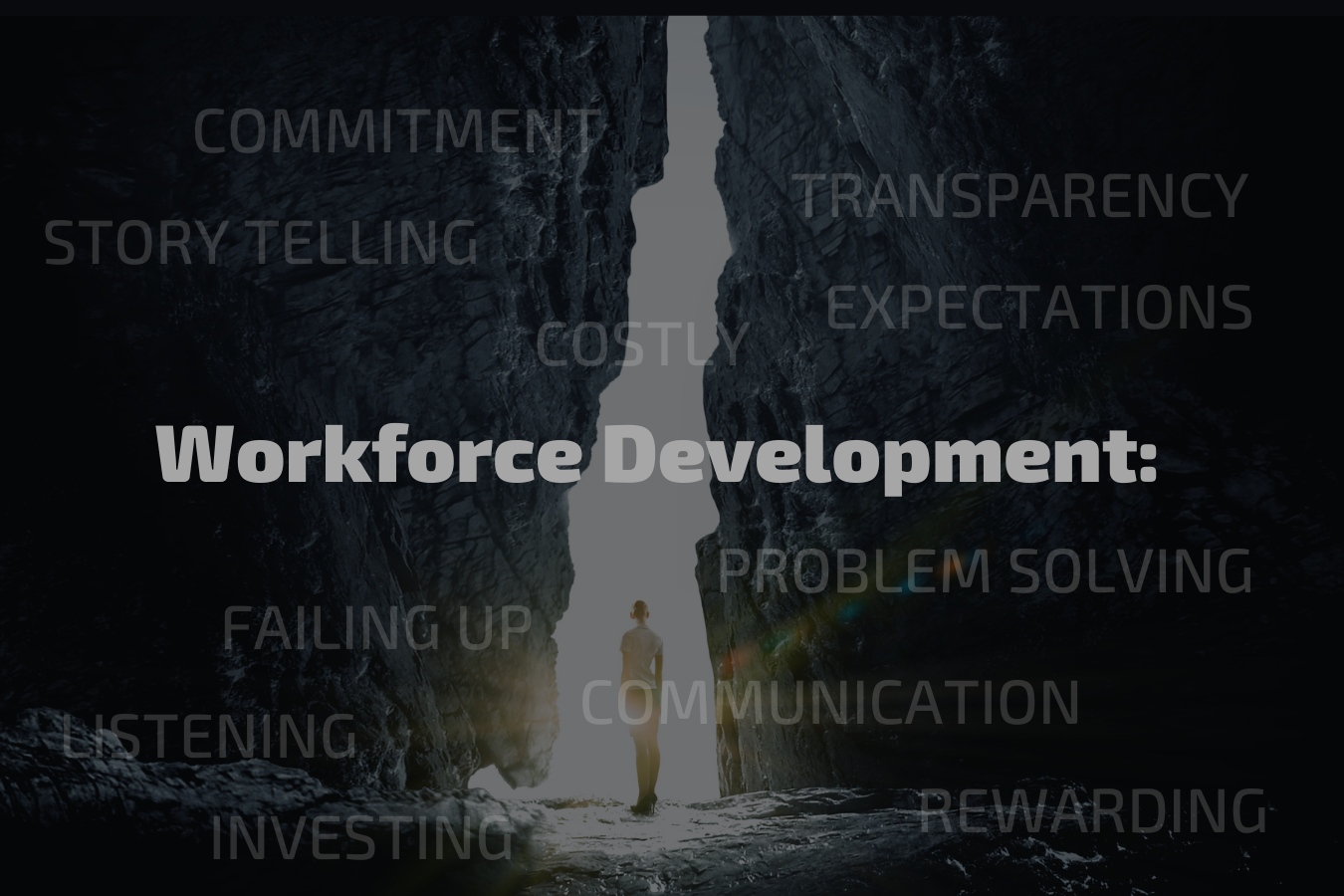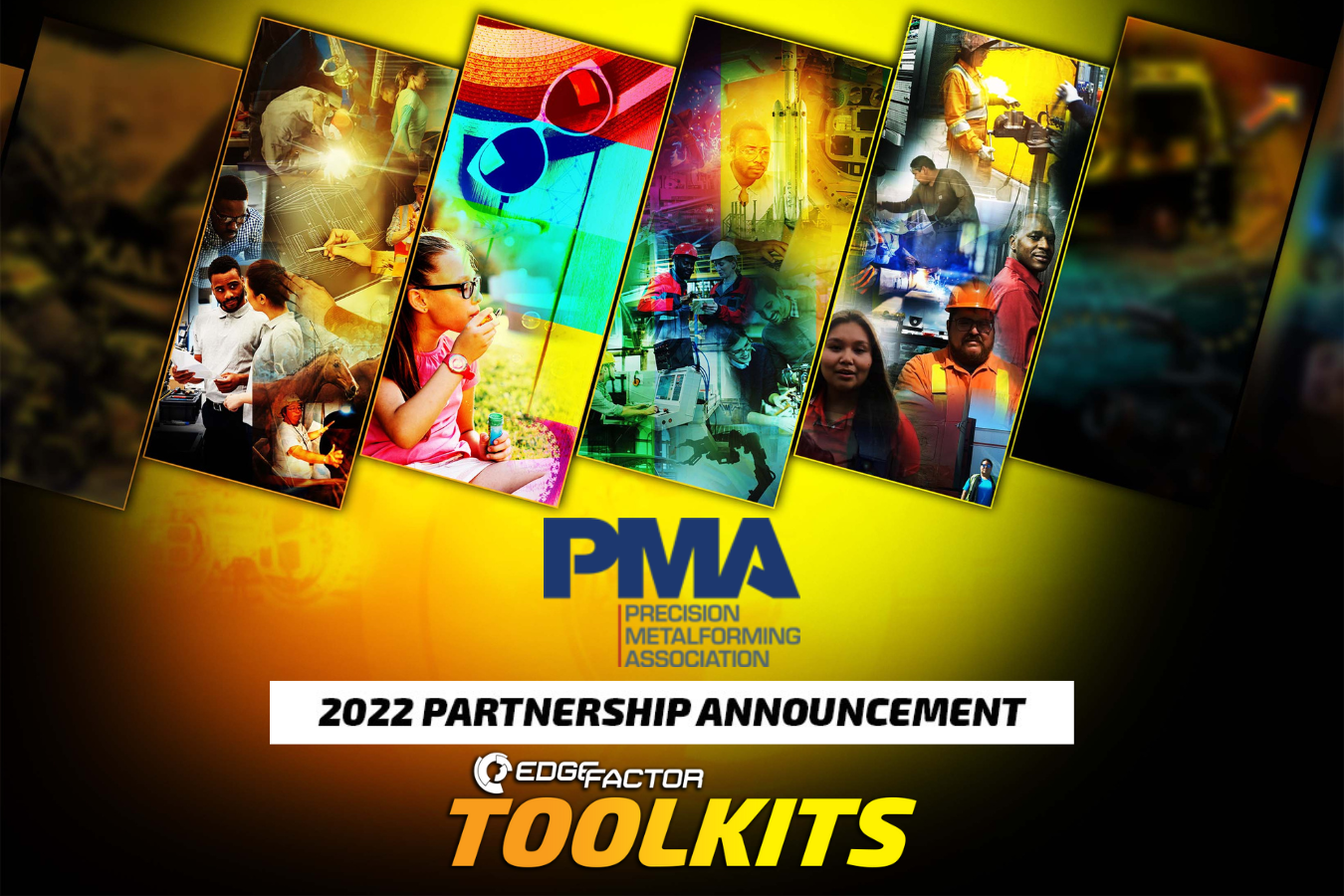
Labor shortage, retiring out of the trades, need for apprenticeships, future workforce… we’re hearing these buzz words a lot these days, from the media to the classroom, the boardroom to the shop floor.
What can we do about it? As a manufacturer turned filmmaker and now platform developer, I can tell you there is a lot each and every one of us can and should do.
For many, the workplace is a meritocracy. You work hard and you get rewarded. But in reality, there are many factors that impact your success in the workplace—your background, education level, and even personality type play a role. One major variable is a commitment to workforce development: having an engaged and motivated workforce that’s ready to learn new skills, adapt quickly to change, or tackle new challenges.
When you are committed to workforce development, it shows in the quality of employees you attract and retain.
When you are committed to workforce development, it shows in the quality of employees you attract and retain. It shows in the quality of work you produce. And it can even show in your relationship with customers.
You want to be known as a company that values its employees, and that means investing time and money into their training so they can thrive on the job. That way, they'll feel motivated to stick around—and loyal customers will notice how much better your business is compared to other options out there! Being committed to developing your workforce can begin to solve the labor shortage problem.
Problem solving is the root of everything.
What initially presents itself as a limitation is actually a challenge to use problem-solving skills to find new ways of thinking, to be creative and resourceful.
In many ways, how we solve problems defines our future. Every problem we encounter leads to a layer of success. The next problem we solve leads to another layer, and layer upon layer, we are building our way to success.
If we avoid problems, we miss opportunities to succeed. It’s in that uncomfortable space that we begin to prove our value to the people around us and to ourselves. This transferable skill is invaluable.
While working in manufacturing, I uncovered a problem. The industry along with many skilled trades is not attracting young workers. Here I was earning a decent income, and my eyes and ears were opened to the work that was being done on the shop floor and to the stories that needed to be told. I wanted to tell stories from behind the lens of the people who were innovating, and solving problems that were impacting the world.
After investing some money into a home-based studio, I started to build a team and in 2010 Edge Factor was born. We launched our first film, The Beginnings, using a new camera rig we built. Edge Factor’s cinematic films speak to the human element of the manufacturing industry. My team gets to interact with so many different things that are completely hidden from the world.
We use media, along with lesson plans and activities to get students interested in manufacturing and debunk the myths that were becoming a problem for us. We’ve had so many educators who told us they used our content for every manufacturing day event they host, and now their students are inspired, but what’s next?
I realized the journey had to continue beyond inspiration. If the journey doesn’t continue then I didn’t solve this initial problem of getting more students into the industry. We had to move these students from inspiration to exploration, to preparation, and ultimately to connection. Connecting students with opportunities and connecting business leaders in the industry with students and job seekers, in their own community.
Then came another layer, we had educators use our content one year, in a specific grade, but then they wanted new content to introduce students at a lower or higher grade level to skilled trades. That brought another problem to solve, how do we engage students at every grade level with the content we are creating?
Edge Factor rose to the challenge. We now have content from K - Gray, so at every stage, everyone in the continuum from the student, to the jobseeker, business leader, to parent, and grandparent can consume Edge Factor content and continue their own journey from Inspiration, Exploration, Preparation to Connection.
The true cost is not investing in workforce development
A lot of us are concerned about the job shortage. So we’re counting the cost. Instead of counting the cost of what it’s going to take to build the future workforce, we should be asking ourselves, what is it going to cost if I don’t get heavily involved in workforce development?
On average employers spend $1000 a year on training each of their employees. Whereas labor shortages cost business billions of dollars. Not to mention that a lack of investing in the development of their workforce has other consequences. When employers don’t invest in their employees, the consequences include workers that are burnt out, emotionally detached and uncommitted to their work.
Here is a list of five practical, cost effective ways to build up your workforce:
-
Create a culture of failing up. Failure is a critical part of success.
When you fail, learn from your mistakes and move on.
The most important thing is to not let failure get you down. When we discovered that Edge Factor's initial goal to inspire students to explore manufacturing careers wasn’t enough, we were challenged but we didn’t give up. We learned from the feedback we received and moved on to create more media and tools while we worked toward the creation of our next great idea.
In many ways Edge Factor is in one of the biggest learning opportunities in our history with the new platform we are launching. It is painful and we have made mistakes but we are learning from them based on feedback we have received from our customers and we are working hard to build the best possible product.
A great lesson on the right response to failure came from Professor Schmitt when we filmed an Edge Factor Show, called Happy Accident. Paul Schmitt works with professional athletes to create specialized skateboards designed to meet their individual needs. These riders come to him with their own ideas of what they want to be able to do with their boards and how they want the board to look. One athlete, in particular, presented a frustrating challenge for Professor Schmitt. Kelvin Hoefler insisted there was something wrong with some of his boards. Instead of making assumptions and losing a customer, Prof. Schmitt had to reflect, analyze and investigate to come up with a solution.
Professor Schmitt learned that one of the molds he used to make the boards had shrunk. However, the out-of-spec mold was responsible for the boards that were perfect for Kelvin.
“The mold was totally out of spec, but he totally loved it, it was right for him, it’s like a happy accident. In my whole career, I hadn’t seen this, it’s crazy.” Professor Paul Schmitt.
Kelvin went on to win the Gold Metal at the X-games competition using the boards made as a result of what could have been a great failure.
What you do with failure will define the rest of your life.
-
Be transparent with your team.
Being transparent with your team shows that you are a person who has nothing to hide and is willing to admit when they are wrong. It also demonstrates that you trust your team, which makes them more likely to trust you in return. This can help build a strong team, where every member feels comfortable offering their opinion on what needs to be done next.
Admit when you’re wrong and move forward together.
It can be hard for managers to admit when they are wrong, but it is an important part of your job as a leader.
Be honest and open. Be willing to admit when you are wrong, right, or don't know the answer.
Admit that sometimes you will not be able to give an immediate response or solution in a meeting because there is more information that needs to be gathered first.
It may seem like admitting that you don't know something will make others think less of you. Actually it shows them they can trust that whatever decision comes out of this conversation will have been carefully considered beforehand instead of being made quickly based on gut instinct alone, which would risk making bad decisions.
-
Communicate, communicate and then communicate some more.
Communication is key when it comes to workforce development. It’s not enough to simply be clear about your objectives and goals. You have to keep everyone in the loop about what has been accomplished, what challenges still exist, and how they can help contribute their part.
Uncommunicated expectations always equal unmet expectations.
Communicate often. The more communication you have with your team members, the more likely they are going to understand where you are coming from and what needs to be done next. So instead of communicating once or twice per week via a one-way email chain—try talking with them face-to-face at least every other day if possible or more frequently if needed. This will give both parties an opportunity for questions/answers as well as feedback on each other's work performance which is essential when trying something new.
-
Do what you said you were going to do. It is as simple as this.
Lead by example more than your words. Show others what behavior you expect from them, by modeling that behavior for them. Showing up and being dependable sounds like a small success, but those small moments, small examples, lead to layer upon layer of success for you and those who are watching you.
-
Ask for cross-generational solutions. Generations approach things from new angles.
If we take a moment to look around us at any given moment, we quickly realize that what is happening around us is not the work of one generation. We are building on the shoulders of the people who have gone before us. We should be honoring them. We should be honoring the past.
At Edge Factor, we do this with the “Careers of the Future” series. We spend the first few minutes of each episode looking back at the roots of where the innovation began that is allowing us to look to the future and the exciting possibilities.
And that is why no matter what stage of life you are at you have a role to play in building the future workforce. Sure, we need more young people in the workforce, however, we need the older generation to invest in them, mentor them, to share the passion they have for their industry.
Your company has a story. Tell it. We all want to be part of a bigger story.
Investing in workforce development is a commitment to your organization and its future. It means you care about the people who work for you, and not just what they can do for your company today. When you make this kind of commitment, it shows in the quality of employees you attract and retain.
As part of Edge Factor’s new platform, we are adding features and upgrades every day. Just one of the ways we are helping jobseekers and companies build the future workforce includes providing an opportunity for job seekers to earn hiring badges.
As students and jobseekers move through the Edge Factor career journey from being inspired by the high-impact media, exploring careers that interest them, and beginning to prepare for those careers, they can learn and earn hiring badges on the Edge Factor platform.
Hiring badges that they can share with prospective employers to showcase the knowledge they have attained regarding the tools, technology, expertise, and soft skills these companies are looking for.
We also launched 2 new series that speak to businesses that are committed to developing a strong workforce:
-
Barriers is a series that discusses barriers that people face on their career journey, and shares best practices for business leaders to help ensure their team members succeed.
-
In the Benchmark series industry leaders talk about the power of apprenticeships and provide insights and best practices on how to launch and develop a successful apprenticeship program.
The resources Edge Factor provides can augment any in-person or virtual event schools or companies can use to bridge the skills gap. We work with companies to create career media, tell their stories and take students on a career journey so they are prepared for future success in whatever industry they choose.
Learn more about Edge Factor
If you are interested in learning more about what an Edge Factor membership can unlock, create your free account or register for an upcoming live webinar.
Get Connected. Stay Connected.
Sign up for the Edge Factor Newsletter and follow us on social media to receive the latest updates on features, events, and initiatives that will help you build your future workforce.
Questions? Feedback? Contact us.
Email: info@edgefactor.com or message us on the Live Chat. We’d love to hear from you.



.jpg)
.png)
.png)
.jpg)